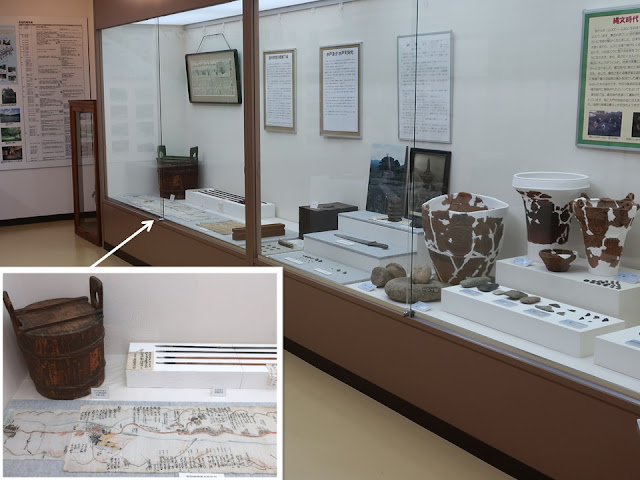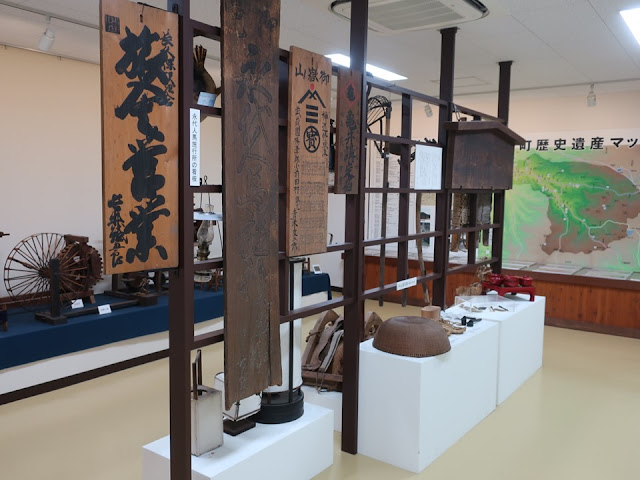Nagawa history museum、長和の里 歴史館
The museum is near Nagakubo post-town in Nagano prefecture of central Japan. The post-town was on Nakasendou highway which linked Edo (old name of Tokyo) and Kyoto in the Edo period (1603~1868). The town museum preserves and exhibits old documents, utensils and so on.
中山道長久保宿(長野県長和町)から少し離れた場所にある古文書や民具の収蔵・展示施設です。
Historical items are displayed on the right side of the exhibition room. The photo on the lower left shows the bomb container and arrows which was used in the Wada pass battle in 1864.
展示室の右側は歴史の展示です。1864年の和田峠の戦い(京を目指す天狗党/水戸藩浪士らと高島藩・松本藩の連合軍と戦い、天狗党は難なく突破)の合戦絵図とともに、水戸浪士が使用した矢と大砲の砲弾を運んだ桶も展示されています(左下)。
At the left side and the center of the exhibition room, items about post-town and old articles for everyday use are exhibited such as tools for silkworm culture.
展示室の中央と左側は、宿場に関する展示品と民具、奥の壁際には養蚕を中心にした道具が展示されています。
The wooden rack for carrying a load on the right has tricolor straps. It’s so stylish!
荷物を背負うときのしょいこ。右側のショルダーストラップがトリコロール・カラーです。おしゃれを楽しんでいますね。
Nagawa is a mountainous area, but there is a blowfish lantern. It was an eyecatcher, I'm sure.
山の中なのに、ふぐ提灯もあります。人目を惹いたかな。
Official website: https://town.nagawa.nagano.jp/life/2020070900138/ (in Japanese), accessed in December, 2023
Kasatori Pass on Nakasendou、笠取峠(中山道)
We can see Mt. Asama from the current pass.
今の笠取峠からは浅間山を望めます。
There is a teahouse at the pass. The picture on the lower left is a teahouse in the Edo period (1603~1868). Both ones are nice. Old renowned watering-places (Gold Spring and Silver Spring) remain (lower right); most of walking travelers drank it. It’s interesting to trace the road on which people have traveled.
今の茶屋と、長久保宿の釜鳴屋さん残されている江戸時代の茶屋・小松屋の絵(左下、長久保宿歴史資料館「一福処濱屋」の展示品/コピー)、何れも味があります。右下は、小松屋跡(今の茶屋と道路を挟んで反対側)の金明水・銀明水。旅人は渇きを癒やしたことでしょう。いにしえを辿る旅は楽しいものですね。
There are pine trees beside the road on the opposite side of the pass. Those were granted by the shogunate, therefore, locals carefully maintained them. they are designated as natural treasure.
峠を下ると立科町です。天然記念物の「笠取峠の松並木」に出ます。小諸藩が幕府から下付された赤松の並木ですが、それだけに大切にされてきました。
Ashida post-town、芦田宿(中山道)
After going down from the pass, there is Ashida post-town. Tsuchiya inn (lower left), which was established in 1804, is operated even until now. The house on the lower right was an inn for daimyo lords (honjin); it has been a someone's residence! I was surprised that honjin are also used as residences in Nagakubo and Odai post-towns which are not so far from Ashida.
峠を下ったところにあります。1804年創業の土屋旅館(左下)は現役、本陣の土屋家住宅は現役の住居です(右下)。長久保宿から小田井宿にかけて、三つの本陣には今も住人がいらっしゃるので、ビックリしました。
The building beside the road is Ashida exchange facility and is also a relocation support center.
街道沿いのふるさと交流館・芦田宿は、移住サポートセンターでもあります。
There are detailed exhibits about Tateshina town in which Ashida post-town in. The photo in the lower left is the special room for a daimyo lord in the honjin.
立科町について丁寧に説明されていて、本陣上段の間の写真も展示されています(左下)。
Motai post-town、茂田井宿(中山道)
Motai is a good old town, which locates between Ashida and Mochizuki. It was not an official post-town; it didn’t have a logistic office, but it had inns. It is pity that its road is too narrow to drive.
芦田宿を江戸側には、望月宿と間の宿・茂田井宿があります。雰囲気は抜群ですが、車で行くには狭い道。
Osawa shuzo (sake brewery) has a folklore museum (but I could not visit this time).
大澤酒造の蔦屋さんには、民俗資料館がありますが、残炎ながら立ち寄れず。
The building above is a sake brewery (Takeshige-honke shuzo), too. A famous poet (Wakayama Bokusui, 1885-1928) made a long stay there. He loved sake so much. The brewer produces sake named “Bokusui”.
100mほど先の叶屋さん(武重本家酒造)。酒を愛した若山牧水が逗留した場所でもあり、「牧水」ブランドの酒もあります。
The old Nakasendou highway which links to Motizuki is calm now.
望月宿へと続く旧中山道。今は静かな道です。
Visited in June, 2023
Previous post (part1 of this article): Nagakubo
post-town and museums (1/2)、長久保宿と資料館 (part1)
Next post (neighboring post-town of Nagakubo): Wada post-town and museums、和田宿と資料館
















Comments
Post a Comment